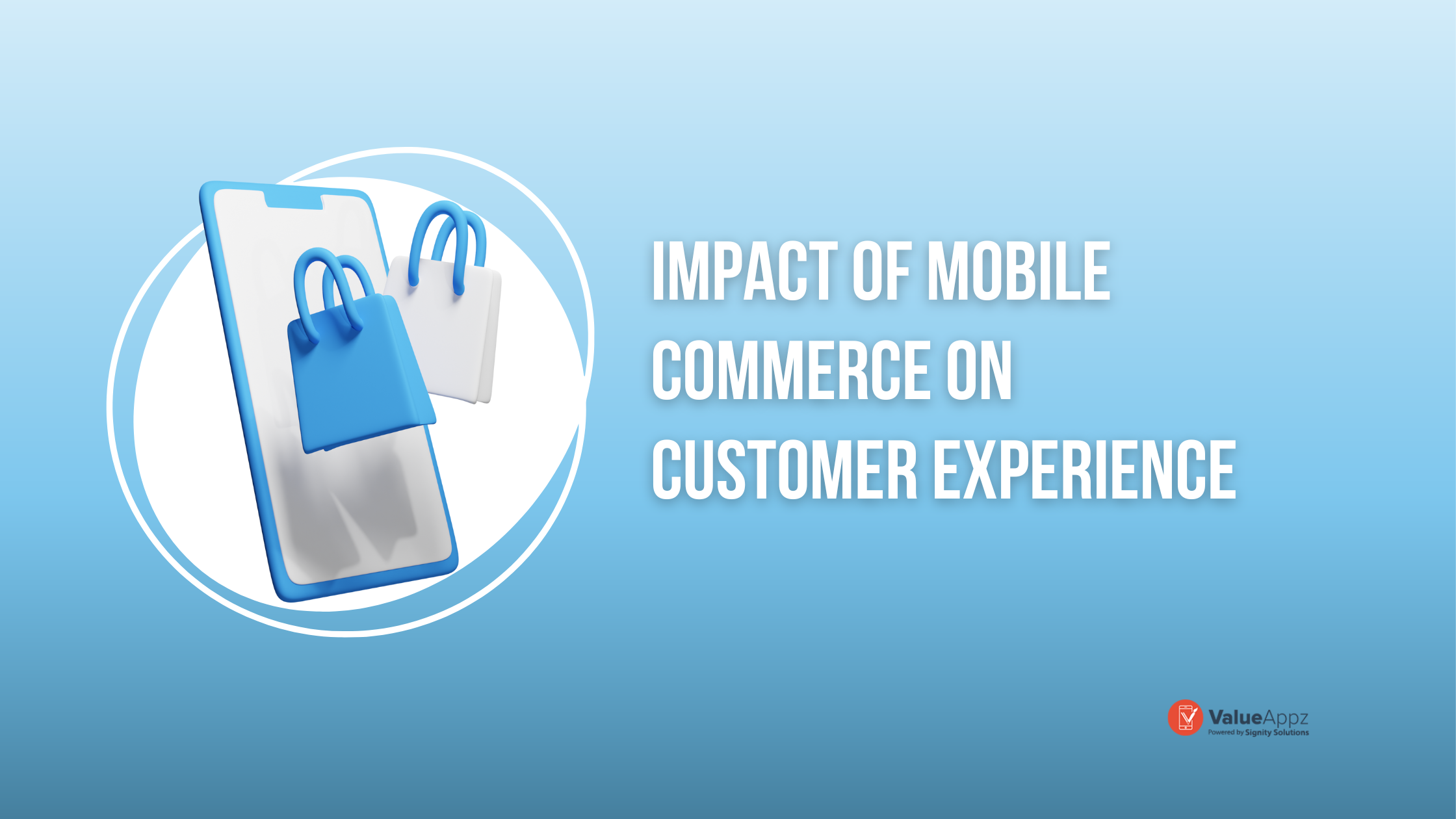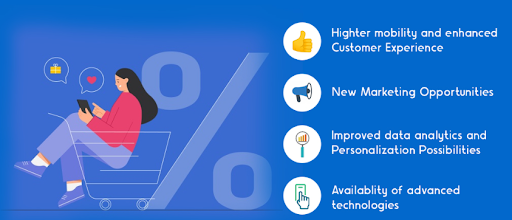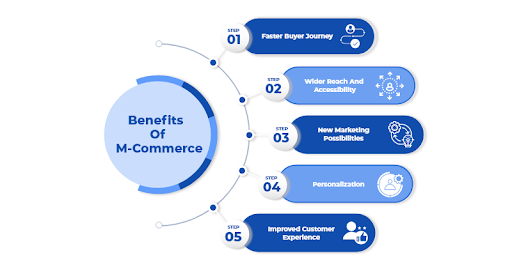How Mobile Commerce is Transforming Customer Shopping Experience

Quick Summary: When eCommerce has already disrupted the whole industry from the ground up, is there anything new that can have the same impact and offer more? M-commerce might be the answer, as it has abruptly become one of the most popular shopping channels. Please read the blog to learn mobile commerce benefits and how it could be the secret to your success.
A user spends 4 hours and 8 minutes on a smartphone on average. That is a lot of time spent on a phone, and a part of it goes towards online shopping on mobile devices. This fact did not go unnoticed by commerce business owners. Retailers began creating apps with easy-to-browse catalogs and a seamless checkout process.
M-commerce is not a new technology or phenomenon. Reports predict 2024 will witness around 187.5 million active mobile shoppers. Whether you are visiting Amazon to buy a product or purchase a Netflix subscription, that is mobile commerce in action. You can find m-commerce examples all around you, especially when approximately half of the eCommerce transactions happen via mobile devices.
Consequently, the estimates say that m-commerce sales will reach $4.5 trillion, making nearly 69.9% of the overall eCommerce sales. But what makes mobile commerce so popular? This article will give you an insight into the impact of m-commerce on brick-and-mortar stores and walk you through the road ahead for its growth. So, keep reading!
Key Takeaways
- The pandemic directly influenced long-term mobile shopping trends as more people leaned toward the online market.
- The increased interest in mobile shopping apps underscores the imperative for commerce business owners to design engaging and mobile-friendly marketplace.
- M-commerce is expected to burst into the mainstream as technological advances promise mobile shopping convenience.
- Mobile commerce includes mobile shopping apps and has more extensive connectivity than eCommerce.
Table of Contents
What is Mobile Commerce?
Mobile Commerce, or m-commerce, is a subset and result of the eCommerce revolution. While eCommerce means buying and selling digitally on all devices, the former is what it sounds like. M-commerce includes online transactions performed over mobile devices such as tablets and smartphones.
Mobile commerce allows store owners to sell their products on mobile devices. It is very convenient; hence, it is no surprise that it is becoming popular in the corporate sector.
Research shows that 49% of shoppers use their mobile devices to compare the pricing of services. Meanwhile, about 40% of users redeem their mobile coupons, and 30% learn more about a product they liked. The numbers only emphasize the accelerating mobile-first shopping strategies. It entails that customers often prefer using smartphones first to engage with your website.
What are the Types of Mobile Commerce?
You can classify mobile commerce into three categories. These include:
1. Mobile Shopping
Gone are the days when customers had to visit your store and queue up at the counter to purchase things. Mobile shopping platforms allow users to buy products and services online through their mobile devices. All they need to do is open your website and find the perfect item they want from the convenience of their home.
You can showcase your exclusive range of products and services on your online platform. This way, users need not be near your desktop every time they shop. Mobile devices will allow them to scroll through your products and buy from anywhere and anytime. Thus it can be a more self-reliant and convenient alternative.
2. Mobile Banking
Financial institutions introduced online banking platforms to facilitate transactions on the mobile screen. Almost every bank has its own adapted version of the website or a mobile application. It allows users to carry out transactions without going to a branch.
Users can now do all their banking transactions with only a few taps on their phones. The application provides clear and concise information and retains a record of your actions within reach.
3. Mobile Payments and Digital Wallets
Innovative and online transaction methods have paved the way for easy mobile payment solutions. M-payments enable customers to pay for their purchases through a mobile device. Apple Pay, CashApp, Google Pay, and Samsung Pay are among the known and trusted payment platforms.
In addition, these mobile payment apps facilitate wallet service for speedy transactions. Digital wallets allow customers to add an electronic version of their card to their account or app inventory. Users can thus move from app mobile search to purchase in seconds.
Reasons for the Rise of Mobile Commerce
Mobile commerce is an extension of eCommerce that has been around for years. But what factors are driving its growth? Here are the primary reasons behind the surge of m-commerce:
1. Mobile Phone Usage
The primary reason for an increase in m-commerce is the natural progression of technology. As per a report, consumers spent 3.8 trillion hours, downloaded 435,000 apps every minute, and paid $320,000 for apps every minute globally. It is evident that users spend more time on mobile devices than desktops.
2. Convenience
Mobile shopping convenience attracts customers and drives significant growth. The choice of many stores and the ability to search for products, compare prices, and finalize the product without leaving home motivates users to shop anytime. M-commerce is likely to continue rising in the future. And a mobile app is the best way to get your share of the pie.
3. Personalization
Customers appreciate self-care and personalized offers. About 71% of customers expect tailored service or interactions. Mobile shopping apps can be a win-win situation. It allows users to access additional products based on their preferences and purchases.
4. Accessibility
Mobile shopping platforms are becoming more profitable for store owners. The app Amazon has 23 billion registered users, while Walmart ranks number one in the US with almost 25 billion registered users. Mobile apps give users access to the whole itinerary from the comfort of their homes. They can track their product and receive delivery notifications.
5. Mobility
Carrying a phone in hand is way easier than a desktop. Mobile devices are smaller. Therefore, users can perform commercial activities anywhere, even in places with no internet and electricity. The portability feature contributes to making m-commerce broader.
Benefits of m-Commerce
Mobile users made up 58.9% of the global web traffic in 2022. It implies that the majority of your customers are mobile-based. Therefore, developing an m-commerce platform is essential to drive success. Mobile commerce benefits you in multiple ways. Some of its positive aspects include:
1. Accessibility to Users
Around 6.6 billion people have a smartphone currently; the number will reach 7.8 billion by 2028. Mobile commerce enables you to tap into new markets you could never access before. Every person with a mobile
device is your potential customer, and such a broad user base promises abundant opportunities for lead generation.
2. Valuable Customer Data
A customer typically enters a store, buys a product, and leaves. You do not know why they picked a specific product and purchased it. M-commerce gives you answers to such questions. You can utilize mobile analytics to track consumer data throughout their journey and gain valuable insights to increase retention rate.
3. Accelerated Buyer Journey
Many store owners believe a responsive website is enough to provide a remarkable customer experience on mobile devices. However, it is far from the truth. Mobile shopping apps are 1.5 times faster when loading results. As a result, they present a quicker way to browse and purchase.
4. New Marketing Opportunities
M-commerce offers several marketing advantages to commerce business owners. You can scale your mobile app marketing by monitoring and analyzing the traffic. You can enhance your marketing features when customer interest spikes and downscale your activities when consumers are less likely to purchase.
How is Mobile Commerce Revolutionizing the Customers’ Shopping Experience?
The emergence of eCommerce has already marked a significant advancement in the corporate sector. Customers could avail themselves of various options using their desktop computers and shop from home. Users can still perform these things; however, they only require a phone in their pocket to do the same.
M-commerce provides several possibilities to help commerce business owners in enhancing the overall mobile shopping experience:
1. Merging Online and Offline Shopping
You can see the impact of mobile commerce on brick-and-mortar stores in various ways. Mobile commerce platforms integrate physical and online shopping. Customers can access online comparison tools when shopping physically and streamline the process.
Let’s understand it better with a practical example. The renowned pizza chain Domino’s has been using mobile commerce since 2014. Not long ago, Domino’s developed a Pie Pass technology to accelerate pizza pick-ups for takeaway customers. Customers can now order via app to skip the line when they grab their order.
2. Authentic Omnichannel Experience
Did you know 90% of customers switch between devices to complete a task? Store owners with omnichannel mobile commerce adoption achieve 91% greater customer retention rates. It means the method of using multiple channels to sell products.
The omnichannel strategy ensures a seamless buying experience and maintains a consistent brand message across all the touchpoints. The well-known U.S. retailer, Target, invested $7 billion to overhaul its supply chain and witnessed a 145% increase in sales.
3. A Wide Range of Payment Solutions
M-commerce makes the transaction process even more effortless with multiple payment solutions. Many applications and websites offer a one-click feature, allowing users to input their payment information only once. They can leverage the one-click option to fill in the desired data every time they purchase.
Take Starbucks, for instance! The coffee giant offered mobile payment options in 2015, which accounted for 20% of transactions in 2017. Starbucks receives online mobile payments from over 23.4 million users every six months.
4. Personalized Experience
Personalization is not new in marketing. But it is a critical factor in the success of mobile commerce. Consumers have higher expectations for customized shopping experiences. In fact, almost 91% of users are more likely to buy from brands that provide them with reoffers and recommendations.
Sephora is one such example. The beauty and cosmetic giant revolutionizes the approaches to self-expression and personal care and has etched its name in the hearts of millions. Its mobile app updates the layout each time a consumer accesses it. Further, it tailors the content according to the user to facilitate personal experience.
Give Wings to Your Business With the Right Application
Mobile commerce has the potential to become a prominent shopping channel and alters consumer behavior. It is a favorable technology for customers and store owners like you alike. Customers can receive customized service discounts, special offers, reminders for saved items or abandoned carts, and a streamlined purchasing process. Meanwhile, you can get a higher return on your marketing budget.
However, it takes more than a compelling interface and graphics to make your mobile app a hit. It is critical to understand the necessity of creating sophisticated yet easy-to-use mobile commerce platforms. Commerce business owners must provide an incredible customer experience on all devices.
Have an idea but are hesitant to begin? Valueappz can help you boost your mobile commerce business and increase your revenue. Our company relies on cutting-edge technology and an advanced technological stack to power up your app solutions. We provide a range of readymade products and offer pre-built integrations to equip your platform with multiple payment solutions and tools. Book our free demo to learn more about our service!
Frequently Asked Question:
Q1. How Does m-Commerce Benefit a Business?
Mobile shopping platforms allow businesses to attract new customers, improve productivity, facilitate fast and secure transactions, and improve the customer experience.
Q2. What is the Key Impact of m-Commerce on Marketing?
Mobile commerce enables customers to buy products at any time. Further, it allows them to compare services and prices across online sellers.
Q3. What are the Limitations of Mobile Commerce?
Mobile commerce security and limited screen space are prominent issues customers encounter. Some people do not trust online payment platforms and face a constant risk of data breaches.
Q4. What is the Role of m-Commerce?
M-commerce helps businesses in leveraging various channels to reach customers worldwide. Customers unable to access in-person stores can shop, order, and pay on mobile platforms.
Q5. What is the Future of Mobile Commerce?
Mobile commerce is evolving and reaching a vaster user base. Store owners and businesses looking forward to achieving success must pivot on the unseizable growth of m-commerce.
THE AUTHOR
Amrita Singh
With a background in Digital Marketing spanning over five years, I bring a unique perspective to my writing and have developed a keen understanding of the ever-evolving digital landscape. I focus on creating content that is relevant and easy to understand.

Get ready to digitally transform your business.
Let our team help take your business to the next level. Contact us today to get started on finding the perfect solutions for your business needs.











